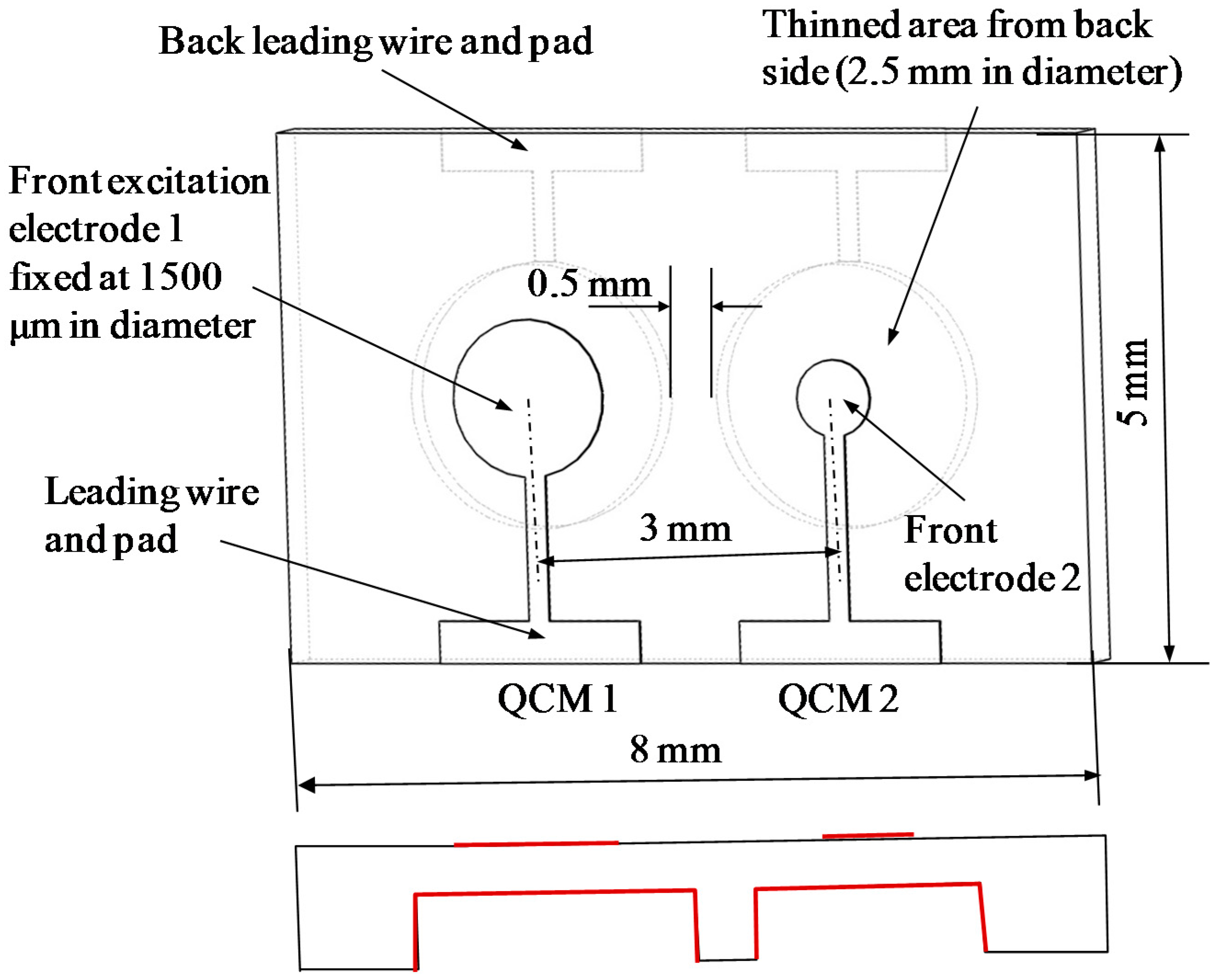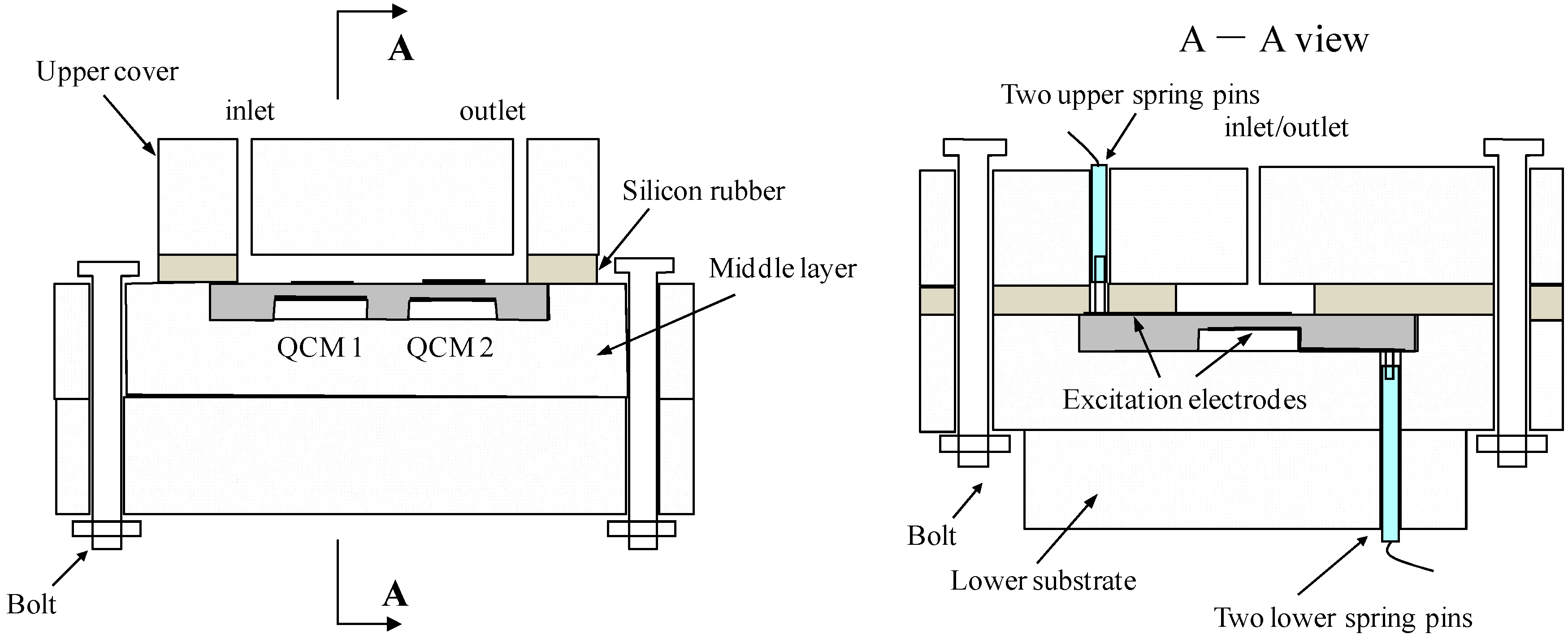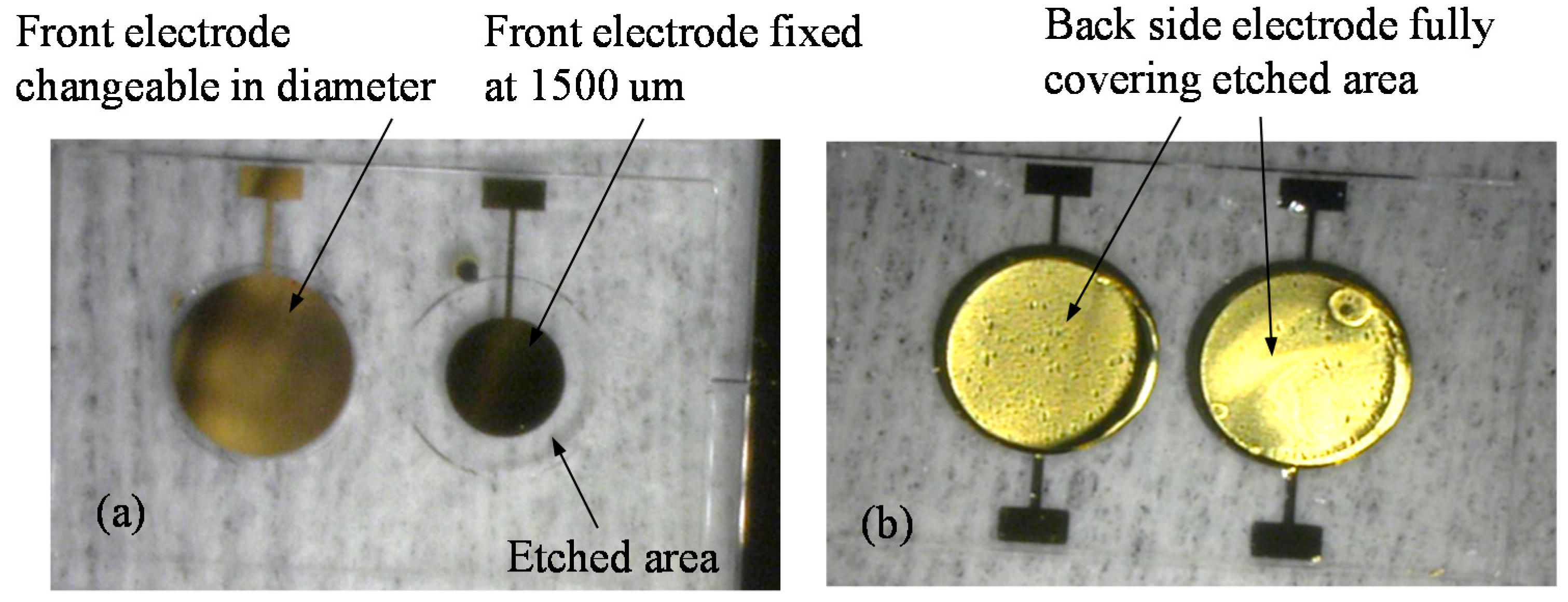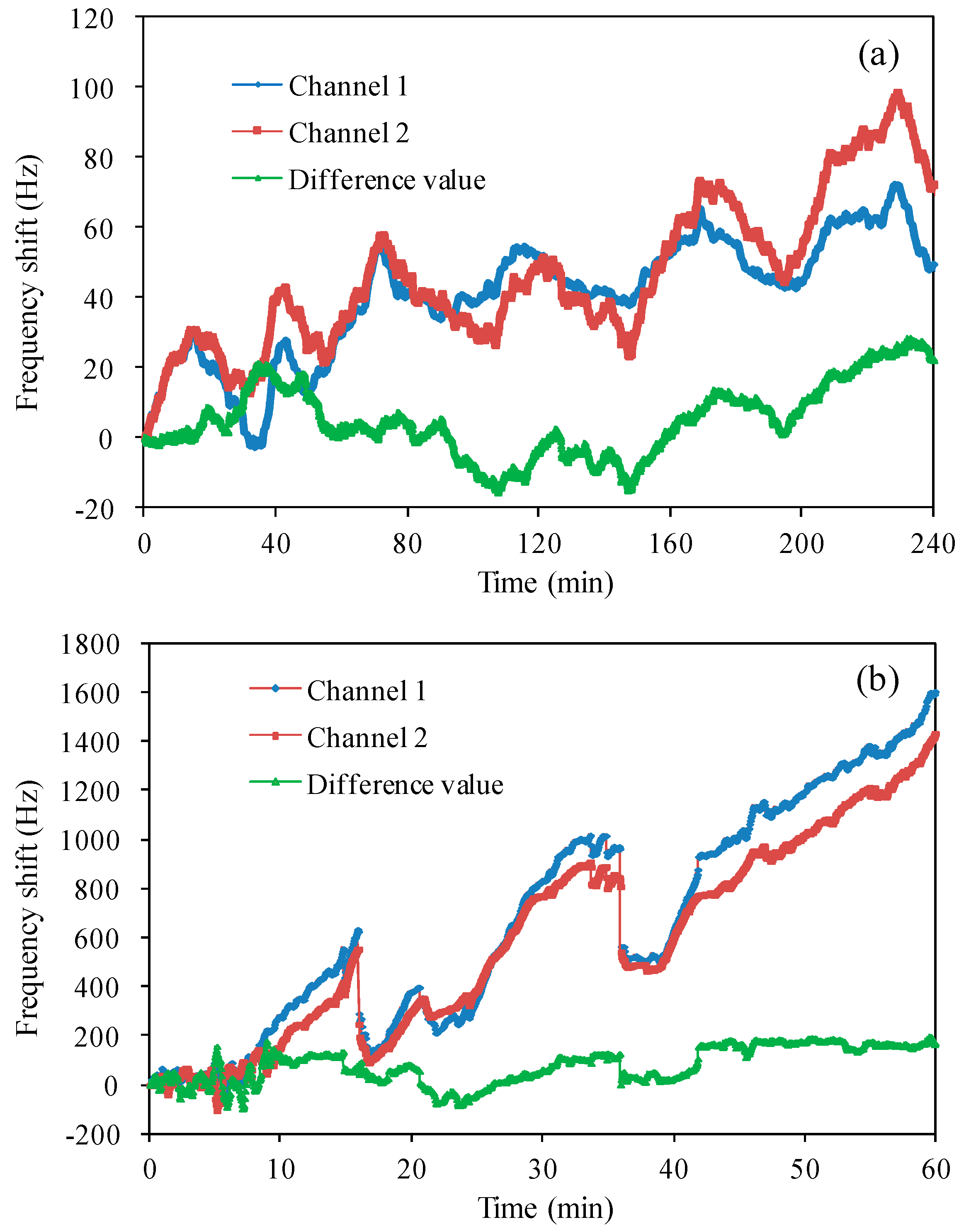Development of a Flow Injection Based High Frequency Dual Channel Quartz Crystal Microbalance
Abstract
:1. Introduction
2. Experimental
2.1. Design and Fabrication
2.2. Evaluation
3. Results and Discussion
4. Conclusions
Acknowledgments
Author Contributions
Conflicts of Interest
References
- Wang, P.; Su, J.; Su, C.F.; Dai, W.; Cernigliaro, G.; Sun, H. An ultrasensitive quartz crystal microbalance-micropillars based sensor for humidity detection. J. Appl. Phys. 2014, 115, 224501. [Google Scholar] [CrossRef]
- Wang, P.; Su, J.; Gong, L.; Shen, M.; Ruths, M.; Sun, H. Numerical simulation and experimental study of resonance characteristics of QCM-P devices operating in liquid and their application in biological detection. Sens. Actuators B Chem. 2015, 220, 1320–1327. [Google Scholar] [CrossRef]
- Esmaeilzadeh, H.; Cernigliaro, G.; Su, J.; Gong, L.; Mirzaee, I.; Charmchi, M.; Sun, H. The effects of material properties on pillar-based QCM sensors. In Proceedings of the ASME 2015 International Mechanical Engineering Congress and Exposition, Houston, TX, USA, 13–19 November 2015; p. 6. [Google Scholar]
- Su, J.; Inalpolat, M.; Ge, T.; Esmaeilzadeh, H.; Sun, H. Experimental study and analysis of dropwise condensation using Quartz Crystal Microbalance. In Proceedings of the ASME 2016, Washington, DC, USA, 10–14 July 2016; p. 7. [Google Scholar]
- Sauerbrey, G. Verwendung von Schwingquarzen zur Wägung dünner Schichten und zur Mikrowägung. Z. Phys. A Hadron. Nucl. 1959, 155, 206–222. [Google Scholar]
- Kanazawa, K.K.; Gordon, J.G. Frequency of a quartz microbalance in contact with liquid. Anal. Chem. 1985, 57, 1770–1771. [Google Scholar] [CrossRef]
- Rocklein, M.N.; George, S.M. Temperature-Induced Apparent Mass Changes Observed during Quartz Crystal Microbalance Measurements of Atomic Layer Deposition. Anal. Chem. 2003, 75, 4975–4982. [Google Scholar] [CrossRef]
- Dunham, G.C.; Benson, N.H.; Petelenqt, D.; Janata, J. Dual Quartz Crystal Microbalance. Anal. Chem. 1996, 67, 267–272. [Google Scholar] [CrossRef]
- Lin, N.; Meng, X.; Nie, J. Dew Point Calibration System Using a Quartz Crystal Sensor with a Differential Frequency Method. Sensors 2016, 16, 1944. [Google Scholar] [CrossRef] [PubMed]
- Abe, T.; Higuchi, M. A Monolithic QCM Array Designed for Mounting on a Flow Cell. IEEE Sens. J. 2011, 11, 86–90. [Google Scholar] [CrossRef]
- Pantalei, S.; Zampetti, E.; Macagnano, A.; Bearzotti, A.; Venditti, I.; Russo, M.V. Enhanced Sensory Properties of a Multichannel Quartz Crystal Microbalance Coated with Polymeric Nanobeads. Sensors 2007, 7, 2920–2928. [Google Scholar] [CrossRef]
- Palaniappan, A.; Su, X.; Tay, F.E.H. Four-Channel QCA Using Mesoporous Silica Films for Gas Sensing Applications. IEEE Sens. J. 2006, 6, 1676–1682. [Google Scholar] [CrossRef]
- Abe, T.; Esashi, M. One-chip multichannel quartz crystal microbalance (QCM) fabricated by Deep RIE. Sens. Actuators A Phys. 2000, 82, 139–143. [Google Scholar] [CrossRef]
- Iqbal, N.; Mustafa, G.; Rehman, A.; Biedermann, A.; Najafi, B.; Lieberzeit, P.A.; Dickert, F.L. QCM-Arrays for Sensing Terpenes in Fresh and Dried Herbs via Bio-Mimetic MIP Layers. Sensors 2010, 10, 6361–6376. [Google Scholar] [CrossRef] [PubMed]
- Shen, F.; Lee, K.H.; O’Shea, S.J.; Lu, P.; Ng, T.Y. Frequency Interference between Two Quartz Crystal Microbalances. IEEE Sens. J. 2003, 3, 274–281. [Google Scholar] [CrossRef]
- Jaruwongrungsee, K.; Waiwijit, U.; Wisitsoraat, A.; Sangworasil, M.; Pintavirooj, C.; Tuantranont, A. Real-time multianalyte biosensors based on interference-free multichannel monolithic quartz crystal microbalance. Biosens. Bioelectron. 2015, 67, 576–581. [Google Scholar] [CrossRef] [PubMed]
- Wang, J.; Shen, L.; Yang, J. Effects of electrodes with continuously varying thickness on energy trapping in thickness-shear mode quartz resonators. Ultrasonics 2008, 48, 150–154. [Google Scholar] [CrossRef] [PubMed]
- Tuantranont, A.; Wisitsora-At, A.; Sritongkham, P. A review of monolithic multichannel quartz crystal microbalance: A review. Anal. Chim. Acta 2011, 687, 114–128. [Google Scholar] [CrossRef] [PubMed]
- Shen, F.; O’Shea, S.J.; Lee, K.H.; Lu, P.; Ng, T.Y. Frequency Interference between Two Mesa-Shaped Quartz Crystal Microbalances. IEEE Trans. Ultrason. Ferroelectr. Freq. Control 2003, 50, 668–675. [Google Scholar] [CrossRef] [PubMed]
- Liang, J.; Huang, J.; Zhang, T.; Zhang, J.; Li, X.; Ueda, T. An Experimental Study on Fabricating an Inverted Mesa-Type Quartz Crystal Resonator Using a Cheap Wet Etching Process. Sensors 2013, 13, 12140–12148. [Google Scholar] [CrossRef] [PubMed]
- Liang, J.; Zhang, J.; Wang, P.; Liu, C.; Qiu, S.; Ueda, T. Development of Portable Quartz Crystal Microbalance for Biosensor Applications. Sens. Mater. 2016, 28, 201–207. [Google Scholar]
- Rabe, J.; Büttgenbach, S.; Schröder, J.; Hauptmann, P. Monolithic Miniaturized Quartz Microbalance Array and Its Application to Chemical Sensor Systems for Liquids. IEEE Sens. J. 2003, 3, 361–368. [Google Scholar] [CrossRef]
- Lu, F.; Lee, H.P.; Lim, S.P. Finite Element Modeling and Analysis of Multi-Channel Quartz Crystal Microbalance. In Proceedings of the IEEE Sensors, Toronto, ON, Canada, 22–24 October 2003; pp. 888–892. [Google Scholar]





| Parameter | Electrode Diameter (μm) | |||||
|---|---|---|---|---|---|---|
| 1500 | 1050 | 1500 | 1500 | 1500 | 1950 | |
| f0 (MHz) | 34.40 | 34.31 | 35.68 | 35.42 | 34.52 | 34.22 |
| Q factor | 10,820 | 31,492 | 12,644 | 17,013 | 14,253 | 10,782 |
| G (ms) | 17.96 | 28.22 | 20.50 | 28.89 | 24.07 | 23.74 |
| Standard deviation (before connecting oscillator) (Hz) | 16 | 5 | 10 | 14 | 12 | 13 |
| Standard deviation (after connecting oscillator) (Hz) | 21 | 27 | 15 | 9 | 20 | 16 |
| Δf (Hz) | 26 | 102 | 141 | 168 | 169 | 64 |
| Channel 1 (Hz) | Channel 2 (Hz) | Difference Value (Hz) | ||
|---|---|---|---|---|
| Air | Average value | 42.14 | 48.44 | 6.30 |
| Standard deviation | 16.00 | 20.48 | 10.64 | |
| Deionized water | Average value | 671.86 | 588.77 | 83.09 |
| Standard deviation | 455.23 | 399.47 | 74.57 |
© 2017 by the authors. Licensee MDPI, Basel, Switzerland. This article is an open access article distributed under the terms and conditions of the Creative Commons Attribution (CC BY) license (http://creativecommons.org/licenses/by/4.0/).
Share and Cite
Liang, J.; Zhang, J.; Zhou, W.; Ueda, T. Development of a Flow Injection Based High Frequency Dual Channel Quartz Crystal Microbalance. Sensors 2017, 17, 1136. https://doi.org/10.3390/s17051136
Liang J, Zhang J, Zhou W, Ueda T. Development of a Flow Injection Based High Frequency Dual Channel Quartz Crystal Microbalance. Sensors. 2017; 17(5):1136. https://doi.org/10.3390/s17051136
Chicago/Turabian StyleLiang, Jinxing, Jing Zhang, Wenxiang Zhou, and Toshitsugu Ueda. 2017. "Development of a Flow Injection Based High Frequency Dual Channel Quartz Crystal Microbalance" Sensors 17, no. 5: 1136. https://doi.org/10.3390/s17051136





